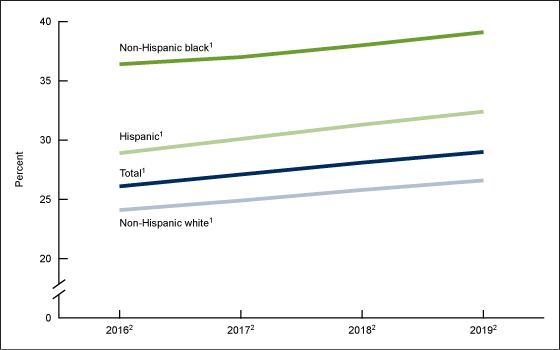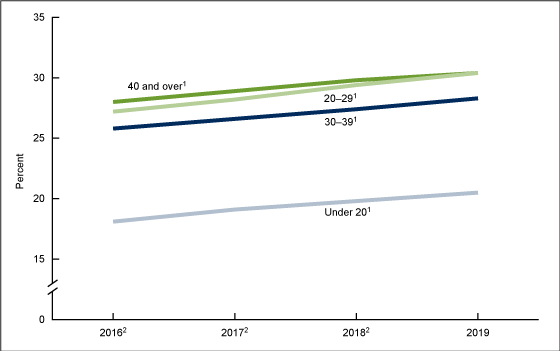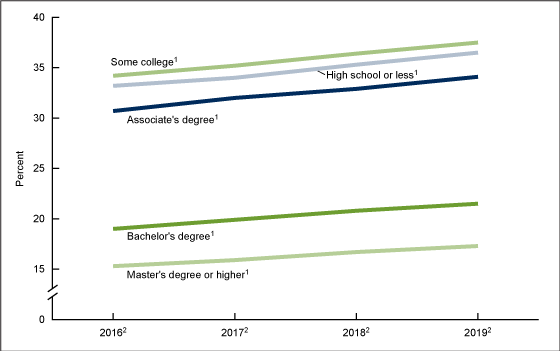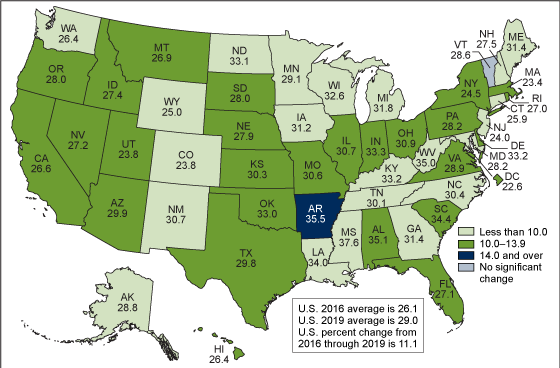Increases in Prepregnancy Obesity: United States, 2016–2019
- Key findings
- Prepregnancy obesity in the United States rose overall and for the three largest race and Hispanic-origin groups from 2016 through 2019.
- Prepregnancy obesity rose from 2016 through 2019 for all age groups.
- Prepregnancy obesity rose among women of all education levels from 2016 through 2019.
- Prepregnancy obesity rose in almost every state in 2019 compared with 2016.
- Summary
- Definitions
- Data source and methods
- About the authors
- References
- Suggested citation
PDF Version (515 KB)
Key findings
Data from the National Vital Statistics System
- Prepregnancy obesity in the United States rose from 26.1% in 2016 to 29.0% in 2019 and increased steadily for non-Hispanic white, non-Hispanic black, and Hispanic women.
- From 2016 through 2019, prepregnancy obesity increased among women of all ages and was lowest for women under age 20 (20.5% in 2019).
- From 2016 through 2019, women with less than a bachelor’s degree were more likely to have prepregnancy obesity than those with a bachelor’s degree or higher, but obesity increased over time among all education levels.
- Compared with 2016, prepregnancy obesity rose in every state but Vermont in 2019.
Obesity (body mass index [BMI] of 30.0 and over) has risen in the United States in recent decades (1). Obesity varies by demographic factors, such as age, race and Hispanic origin, and socioeconomic status (2,3). Maternal obesity has been linked to a variety of adverse health outcomes for mothers and newborns, including gestational diabetes, hypertension, preeclampsia, cesarean delivery, preterm delivery, large size for gestational age, and infant death (4–10). The 2016 natality data file is the first for which prepregnancy BMI is available for all states and the District of Columbia (D.C.). This report presents trends in prepregnancy obesity for 2016 through 2019 by maternal race and Hispanic origin, age, and educational attainment. Trends by state for 2016–2019 and 2019 rates also are shown.
Keywords: National Vital Statistics System, body mass index, maternal factors, trends
Prepregnancy obesity in the United States rose overall and for the three largest race and Hispanic-origin groups from 2016 through 2019.
- The percentage of women with prepregnancy obesity rose from 26.1% in 2016 to 29.0% in 2019, an 11% increase
(Figure 1). - The percentage of non-Hispanic white women with obesity rose 10% (from 24.1% to 26.6%), 7% for non-Hispanic black women (36.4% to 39.1%), and 12% for Hispanic women (28.9% to 32.4%).
- During each year from 2016 through 2019, the percentage of women with prepregnancy obesity was highest for non-Hispanic black women and lowest for non-Hispanic white women.
Figure 1. Prepregnancy obesity, by maternal race and Hispanic origin: United States, 2016–2019
1Significant increasing trend from 2016 through 2019 (p < 0.05).
2Significant difference between all race and Hispanic-origin groups (p < 0.05).
NOTES: Obesity is a body mass index of 30.0 or higher. Total includes all race and Hispanic-origin groups. Access data table for Figure 1.
SOURCE: National Center for Health Statistics, National Vital Statistics System, Natality file.
Prepregnancy obesity rose from 2016 through 2019 for all age groups.
- The percentage of women with prepregnancy obesity rose 13% for women under age 20 (from 18.1% in 2016 to 20.5% in 2019), 12% for women aged 20–29 (27.2% to 30.4%), 10% for women aged 30–39 (25.8% to 28.3%), and 9% for women aged 40 and over (28.0% to 30.4%)
(Figure 2). - Women under age 20 were the least likely to have prepregnancy obesity compared with women of all other ages for each year from 2016 through 2019.
Figure 2. Prepregnancy obesity, by maternal age: United States, 2016–2019
1Significant increasing trend from 2016 through 2019 (p < 0.05).
2Significant difference between all age groups (p < 0.05).
NOTES: Obesity is a body mass index of 30.0 or higher. Total includes all race and Hispanic-origin groups. Access data table for Figure 2.
SOURCE: National Center for Health Statistics, National Vital Statistics System, Natality file.
Prepregnancy obesity rose among women of all education levels from 2016 through 2019.
- Among women aged 25 and over, prepregnancy obesity increased by 10% for women with a high school education or less (from 33.2% to 36.5%) and for women with some college education (from 34.2% to 37.5%) (Figure 3).
- Prepregnancy obesity rose by 11% for women with an associate’s degree (from 30.7% to 34.1%), 13% for women with a bachelor’s degree (19.0% to 21.5%), and 13% among those with a master’s degree or higher (15.3% to 17.3%).
- During each year from 2016 through 2019, women with less than a bachelor’s degree were more likely to have prepregnancy obesity than those with a bachelor’s degree or higher.
Figure 3. Prepregnancy obesity, by maternal education: United States, 2016–2019
1Significant increasing trend from 2016 through 2019 (p < 0.05).
2Significant difference between all education groups (p < 0.05).
NOTES: Obesity is a body mass index of 30.0 or higher. Total includes all race and Hispanic-origin groups. Access data table for Figure 3.
SOURCE: National Center for Health Statistics, National Vital Statistics System, Natality file.
Prepregnancy obesity rose in almost every state in 2019 compared with 2016.
- During 2019, prepregnancy obesity increased in 49 states and D.C. compared with 2016; no significant increase was seen in Vermont (Figure 4).
- Prepregnancy obesity increased by less than 10.0% in 22 states, between 10.0% and 13.9% in 26 states and D.C., and by 22.0% in Arkansas.
- During 2019, prepregnancy obesity ranged from a low of 22.6% in D.C. to a high of 37.6% in Mississippi.
Figure 4. Prepregnancy obesity, 2019 and percent change, 2016–2019: United States and each state
NOTES: Obesity is a body mass index of 30.0 or higher. Increases from 2016 through 2019 are significant (p < 0.05). Access data table for Figure 4.
SOURCE: National Center for Health Statistics, National Vital Statistics System, Natality file.
Summary
During 2019, almost 3 in 10 (29.0%) women had obesity prior to becoming pregnant, an 11% increase from 2016 that continued the pattern seen prior to 2016 (11,12). Increases occurred across all maternal ages, race and Hispanic-origin groups, and educational levels shown in this report. Women under age 20 and those with a bachelor’s degree or higher were the least likely to have obesity; however, these groups had greater percentage increases in prepregnancy obesity from 2016 through 2019 than women aged 20 and over and women with less education.
Prepregnancy obesity increased in all states but Vermont in 2019 compared with 2016; increases ranged from 4% to 22%. The lowest level in 2019 was seen in D.C.; the highest in Mississippi.
Definitions
Body mass index (BMI): Measure of body fat based on height and weight and calculated as
kg/m2 (703 ∙ lbs/in2). BMI values under 18.5 were classified as underweight; those from 18.5 to 24.9 were classified as normal or healthy weight; values from 25.0 to 29.9 were classified as overweight; and values of 30.0 and over were classified as obese.
Educational attainment: The highest degree or level of school completed by the mother at the time of birth. The education categories are 8th grade or less; 9th through 12th grade, with no diploma; high school graduate or GED completed; some college, but no degree; associate’s degree; bachelor’s degree; master’s degree; and doctorate or other professional degree.
Prepregnancy weight and height: Mother’s weight immediately before pregnancy was reported by the mother via the question, “What was your prepregnancy weight, that is, your weight immediately before you became pregnant with this child?” Mother’s height also was reported by the mother via the question, “What is your height?”
Data source and methods
This report is based on data from the Natality Data Files from the National Vital Statistics System. The vital statistics’ natality file is created from birth certificates and includes information for all births occurring in the United States. The natality files include information on a wide range of maternal and infant demographic and health characteristics for babies born in the United States.
Race and Hispanic origin are reported separately on the birth certificate. Persons of Hispanic origin may be of any race. Persons of non-Hispanic ancestry are further classified by race. Race categories are based on the 1997 Office of Management and Budget standards. Single race is defined as only one race reported on the birth certificate.
References to differences in prepregnancy obesity percentages between groups mean that the difference is statistically significant at the 0.05 level based on a two-tailed z test. References to increasing trends are statistically significant at the 0.05 level and were assessed using the Cochran–Armitage test for trends, a modified chi-squared test.
Analyses of educational attainment were limited to women aged 25 and over.
About the authors
Anne K. Driscoll and Elizabeth C.W. Gregory are with the National Center for Health Statistics, Division of Vital Statistics, Reproductive Statistics Branch.
References
- Hales CM, Fryar CD, Carroll MD, Freedman DS, Ogden CL. Trends in obesity and severe obesity prevalence in US youth and adults by sex and age, 2007–2008 to 2015–2016. JAMA 319(16):1723–5. 2018.
- Hales CM, Fryar CD, Carroll MD, Freedman DS, Aoki Y, Ogden CL. Differences in obesity prevalence by demographic characteristics and urbanization level among adults in the United States, 2013–2016. JAMA 319(23):2419–29. 2018.
- Branum AM, Kirmeyer SE, Gregory ECW. Prepregnancy body mass index by maternal characteristics and state: Data from the birth certificate, 2014. National Vital Statistics Reports; vol 65 no 6. Hyattsville, MD: National Center for Health Statistics. 2016.
- Gaillard R, Durmuş B, Hofman A, Mackenbach JP, Steegers EAP, Jaddoe VWV. Risk factors and outcomes of maternal obesity and excessive weight gain during pregnancy. Obesity 21(5):1046–55. 2013.
- McDonald SD, Han Z, Mulla S, Beyene J, Knowledge Synthesis Group. Overweight and obesity in mothers and risk of preterm birth and low birth weight infants: Systematic review and meta-analyses. BMJ 341:c3428. 2010.
- Cnattingius S, Villamor E, Johansson S, Bonamy AKE, Persson M, Wikström AK, Granath F. Maternal obesity and risk of preterm delivery. JAMA 309(22):2362–70. 2013.
- Meehan S, Beck CR, Mair-Jenkins J, Leonardi-Bee J, Puleston R. Maternal obesity and infant mortality: A meta-analysis. Pediatrics 133(5):863–71. 2014.
- Bodnar LM, Siminerio LL, Himes KP, Hutcheon JA, Lash TL, Parisi SM, Abrams B. Maternal obesity and gestational weight gain are risk factors for infant death. Obesity 24(2):490–8. 2016.
- Nommsen-Rivers LA, Chantry CJ, Peerson JM, Cohen RJ, Dewey KG. Delayed onset of lactogenesis among first-time mothers is related to maternal obesity and factors associated with ineffective breastfeeding. Am J Clin Nutr 92(3):574–84. 2010.
- Mills JL, Troendle J, Conley MR, Carter T, Druschel CM. Maternal obesity and congenital heart defects: A population-based study. Am J Clin Nutr 91(6):1543–9. 2010.
- Fisher SC, Kim SY, Sharma AJ, Rochat R, Morrow B. Is obesity still increasing among pregnant women? Prepregnancy obesity trends in 20 states, 2003–2009. Prev Med 56(6):372–8. 2013.
- Deputy NP, Dub B, Sharma AJ. Prevalence and trends in prepregnancy normal weight–48 states, New York City, and District of Columbia, 2011–2015. MMWR Morb Mortal Wkly Rep 66(51–52):1402–7. 2018.
Suggested citation
Driscoll AK, Gregory ECW. Increases in prepregnancy obesity: United States, 2016–2019. NCHS Data Brief, no 392. Hyattsville, MD: National Center for Health Statistics. 2020.
Copyright information
All material appearing in this report is in the public domain and may be reproduced or copied without permission; citation as to source, however, is appreciated.
National Center for Health Statistics
Brian C. Moyer, Ph.D., Director
Amy M. Branum, Ph.D., Acting Associate Director for Science
Division of Vital Statistics
Steven Schwartz, Ph.D., Director
Isabelle Horon, Dr.P.H., Acting Associate Director for Science



